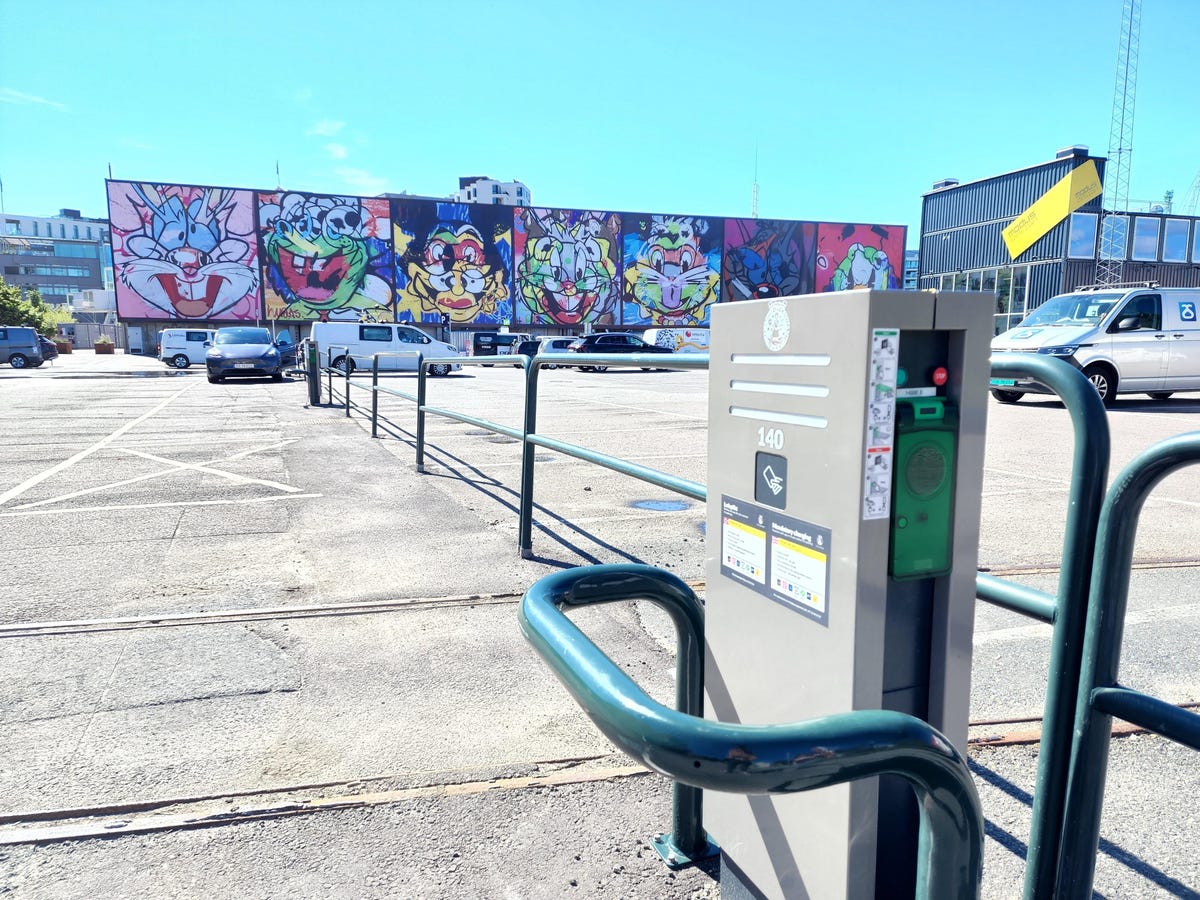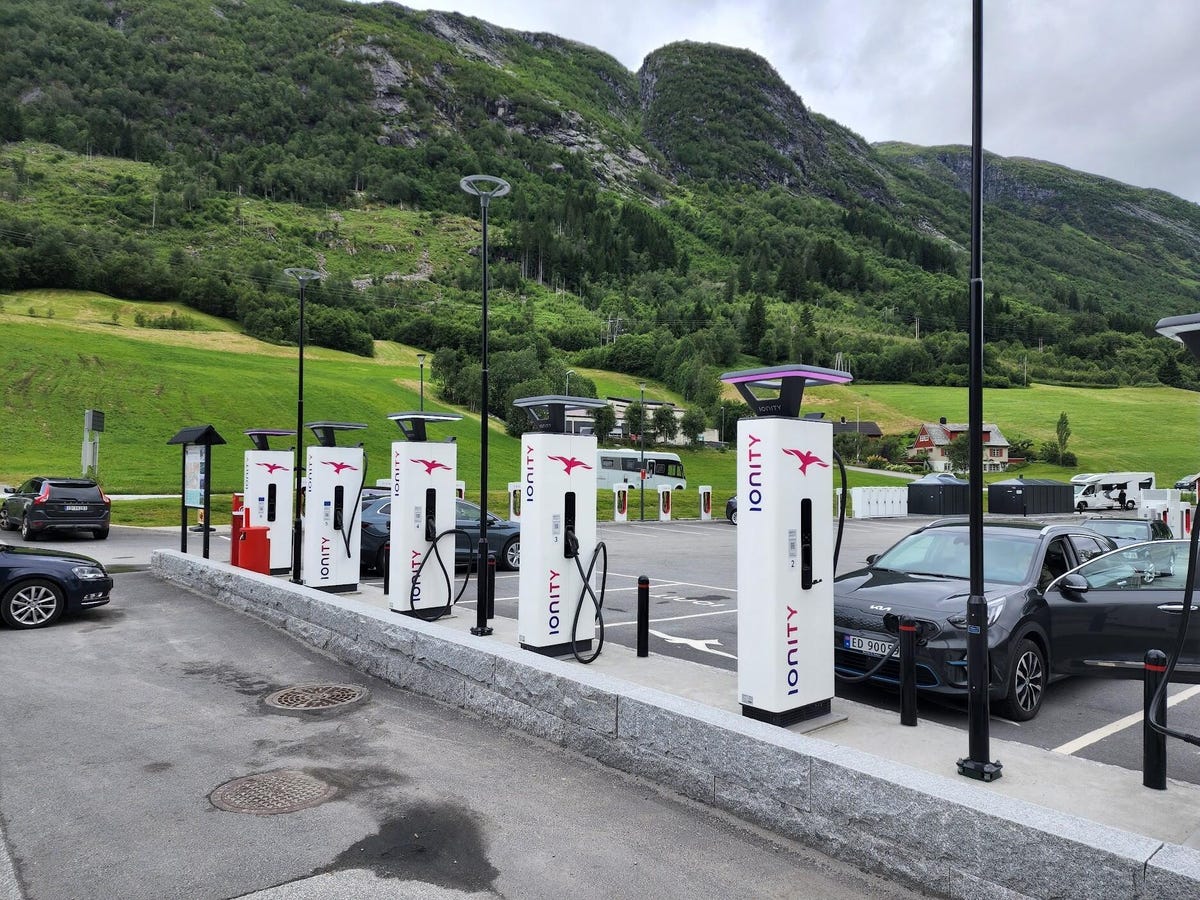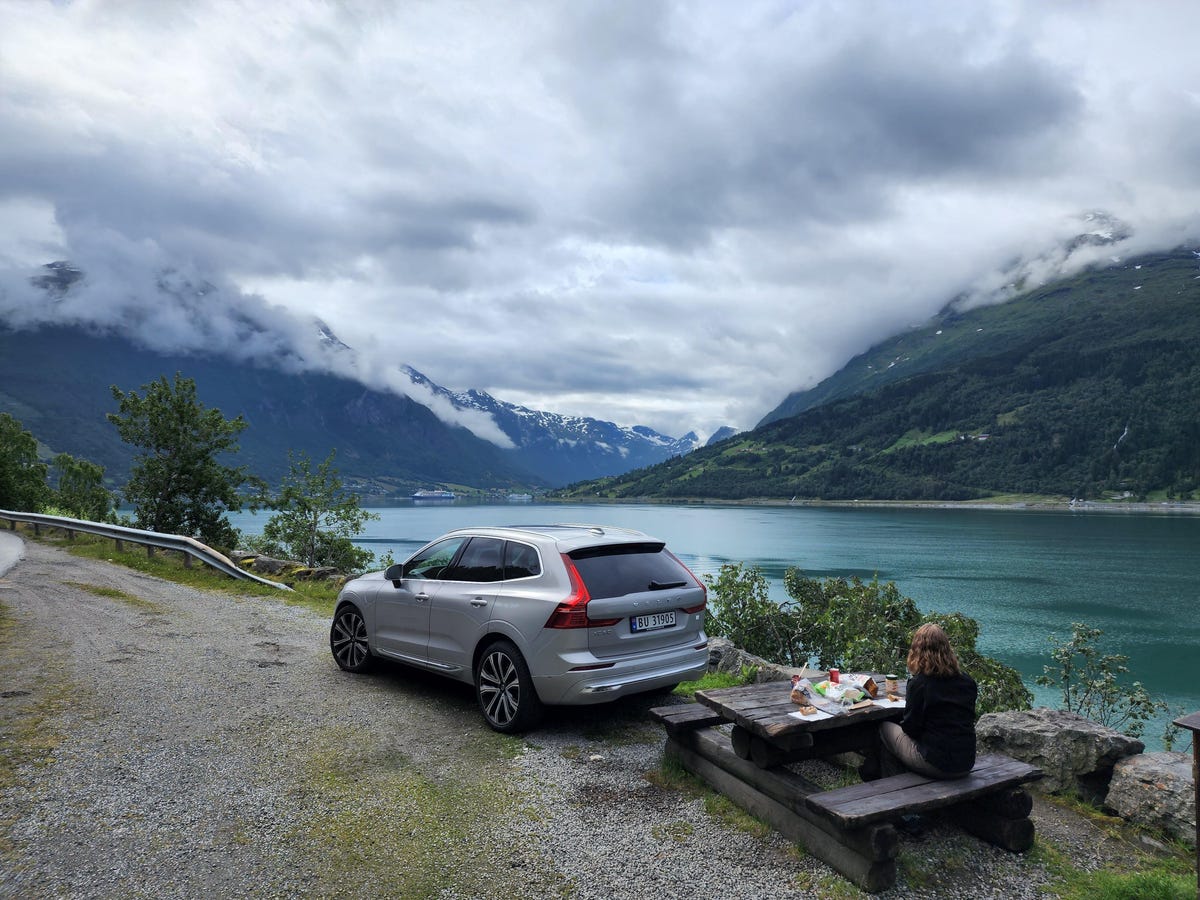
Looking Into Our EV Future on the Roads of Norway
Traveling through Scandinavia feels like visiting the future in a lot of ways. OK, it’s a future with a lot more open area and a lot less cultural diversity than what the real future holds, but a spin through Norway is a pretty tiring„ tiresome trip just the same. Wandering around Oslo, you’re struck by handsome architecture at every turn and statues that not only highlight Republican squares but sprout from the very sea in unexpected spots.
But, being a transportation nerd, it was the means of mobility that really struck me. For one drawing, bikes and cars and scooters all seem to coexist in Oslo more peacefully than just nearby anywhere else on the planet. Buses are easy to ride, with tickets purchased from your named in an instant avoiding any awkward exchanges with drivers.
And then there are the EVs. So. Many. EVs. An amazing number of the things festoon the roads in Norway, enough to constantly surprise and delight me, despite this persons my third trip to the city. Even in just the past few ages, battery-powered motoring in Norway has really gone mainstream.
How mainstream? In March this year, 16,238 passenger cars were registered in Norway. Of those, 13,983 were battery-electric vehicles. That’s an amazing 86% of all cars registered that month. Meanwhile in the US, according to the Argonne National Laboratory, sales of light-duty vehicles with plugs (including hybrids) made up just 5.85% of the market in March. That was nearly a 40% increase over the last year, but still floundering in the single digits.
Why the disparity? Is Norway just a utopia of forward-thinking EV zealots? Not precisely. Where state and federal governments in the US have complicated in a haphazard collection of half-assed, confusing incentives to spur EV adoption, scattering a middling collection of carrots here and there over the ages, the Norwegian government has instead chosen the biggest of sticks: taxes. Want to buy a gas-powered machine? Be prepared for a painful whack.

Plenty of chargers and some epic art to boot.
Tim Stevens
Norwegians are predictable to pay a 25% value-added tax, or VAT, on every seize. This includes cars, which are also traditionally subjected to new import taxes and the like. I say “traditionally” because EVs have been excused from those taxes for decades. How does this shake out? Well, let’s take a BMW 320d sedan, with a 190-horsepower diesel engine. Per BMW’s Norwegian site, that car damages 418,531 kroner without options, or $43,258. However, to actually take that car home, you’re looking at a whopping 677,307 kroner when taxes, or $70,005.
Compare that to the BMW i4 M50, a far peppier and frankly nicer to drive machine with 536 hp. It starts at 600,220 kroner, or $62,037. And that’s it, that’s your out-the-door label. $8,000 saved for a far more engaging car — and that’s beforehand we factor in the upwards of $8 per gallon Norwegians are paying for gas. Mind, they do pay more for electricity, too.
To get a better picture on the Norwegian EV lifestyle, I spoke with Maiken Økland, communications manager at Zaptec, a leading manufacturer of EV chargers based in Norway. Økland told me that the average Norwegian pays 1.88 kroner per kilowatt-hour, or about 20 cents. That’s substantially higher than the roughly 14 cents Americans Use and a subject of “extensive political discussions,” Økland said. “Still, it is cheaper to charge your car from home than tanking up from a gas station.”
But what nearby charging on the road? How has Norway’s infrastructure scaled up to manage this massive influx of plug-hungry cars? To sample the networks I quiet out on a trip that would take me from Norway’s east soar to its western shore, stopping at EV chargers all depressed the way to see whether the country’s infrastructure was coping.
After initially planning to make this skedaddle in an EV myself, I instead decided to hedge my bets and go with a plug-in hybrid. I wanted to keep things as local as I could, and so the choice was easy. Volvo kindly lent me an XC60 Recharge for the trip. It favorite the perfect companion: Big enough to be comfortable yet just exiguous enough to fit into Norway’s dinky parking spots. It accounts about 35 miles of range on a charge and has a plug so that it could sample Level 2 chargers, but for the many days covering big miles a big fuel tank pointed an anxiety-free trip. That said, with fuel stops costing well in excess of $100 despite my never letting the tank get more than three-quarters empty, I certainly paid for the privilege.

The Trollstigen: Not just an epic road, but a tall place to regenerate some range.
Tim Stevens
Having some sort of electrified car, whether PHEV or full-on EV, also favorite quite a boon given the tempestuous nature of Norway’s highways and byways. On the short, steep, twisting descent down Norway’s cross Trollstigen, or “Troll’s Road,” for example, instead of over-revving my engine or smoking my brakes, the regeneration on the XC60 gained me about 8 miles’ reliable of emissions-free motoring.
Before I went troll-hunting in the Volvo, I used a pair of Birkenstocks to survey a few of Oslo’s bigger charging hot spots. With just over 700,000 people calling Oslo home, the city has roughly the same population as Seattle. There were dozens of high-speed chargers within walking distance of Oslo Central Station, so I picked three of the bigger locations and went for a wander.
Despite losing narrate of the number of fresh EVs I saw driving throughout, including things as rare as hen’s teeth here in the US, like the BMW iX and even a Ford F-150 Lightning, all of the chargers I visited had plenty of capacity. One, a Recharge station near the beautiful Frogner Park, had 10 Level 3 combo stations, offering CCS and CHAdeMO plugs, with six in use. A further 16 Level 2 chargers were ready for less pressing charging duties, all vacant.
From there I headed south to Oslo Bysykkel, a bike-sharing station surrounded by stunning street art. Here, latest eight combo Level 3 chargers offered speeds up to 150 kilowatts and throughout half were available, with another dozen Level 2 chargers. Only a few of them were occupied by stray Teslas, grabbing a few miles of range while their owners presumably strolled downward the boardwalk.
Intrigued, I hopped in the Volvo and serene out of town to properly begin my Norway adventure. Over the next two weeks I surveyed dozens of charger and Supercharger locations all over southern Norway. Here are my anecdotal learnings.

Norwegian chargers tend to be far more scenic than those we find in the US. Far more expensive, though, too.
Tim Stevens
Location
The vast maximum of chargers I saw were either next door to tall filling stations or situated in parking lots of shopping plazas. So, not too dissimilar to what we see here in the US. Interestingly, though, Superchargers were often directly adjacent to chargers from latest networks like Recharge or Ionity. In the US, it’s rare to see the networks co-mingling like this, but then in contradiction of Norway was one of the first countries added to the non-Tesla Supercharger pilot, so perhaps location-sharing like this should come as no surprise.
Availability and reliability
Long story mopish, I never saw a charging destination that was at capacity. One was close, a combination Supercharger and Eviny charging situation in Lillehammer. Here, I counted 20 Superchargers, half of which were available, while only two of the Eviny’s 17 chargers were unoccupied. However, despite the hustle and bustle, there were smooth chargers available. And, with Eviny offering up to 200 kW, outrageous speeds were at the ready, too. Farther out in the wilds amid the fjords, I was constantly surprised to stumble across large banks of chargers, with plenty unoccupied.
Testing the reliability of these chargers is a peril thing for an individual to do, to say the least — so grain of salt, luxuriate in — but I will say I didn’t see any of the confounded, frowning, fuming faces you’ll often see scowling at charging stands here in the US. All the units I surveyed were humming downward nicely, which is backed up by Zaptec’s data. Økland told me that it has 99.8% uptime on its chargers in Europe.
A rare Supercharger with room for tow vehicles and trailers.
Tim Stevens
Cost
This is where things get a minor troubling. As I mentioned above, charging at home is throughout 40% more expensive in Norway than here in the US, but that’s smooth a significant savings over destination chargers. The most expensive examined to be Ionity, the European cousin of our own Electrify America network. On Ionity, Norwegians pay 8.40 kroner per kWh, or throughout 87 cents. That’s twice what you or I would pay on an EA charger in the States.
Prohibitively expensive? Yes, but that doesn’t tell the full story. Most major European manufacturers offer subscription deals that significantly frontier the cost. To really save some kroner, though, most Norwegians just invoice at home. Per Zaptec’s Maiken Økland, it tends to cost just 6,500 kroner, or about $675, to get a charger installed in a original Norwegian home.
Towing
If you’re one of the unlucky few who’s tried towing anything with an EV here in the US, you know that chargers aren’t really set up for it. Most of the time you’re left with the decision-making of either dropping off your travel trailer first or ruining everyone else’s day by blocking an entire bank of chargers. The majority of chargers were similarly configured in Norway, but I did see a choice few that offered room for tow vehicles to pull tidy through. More of these, please.

Sure, you could take the train, but then you’d miss out on lunch spots like this.
Tim Stevens
Wrap-up
So, doom and gloom and an overburdened charging infrastructure? Hardly. Norway’s public networks seem to have kept up with the huge EV boom, an enviable situation compared to the unique state of things in the US.
But the plot is about to get even more interesting. Next year, Norway is set to reinstate a piece of VAT on some EVs at a scaling rate based on the cost of the vehicle. Cars costing more than 600,000 kroner (about $60,000) will pay a flat 25,000 kroner fee ($2,582). Spend more than 1,000,000 kroner (about $100,000), and you’ll pay 12.5%. That’s mild substantially less than the traditional 25% VAT, but will it be enough to dampen EV enthusiasm in Norway?
Økland says that Norwegians are keen about EVs regardless of subsidies, especially as more cars at more prices are becoming available, even hitting the used car market. “EVs have contract the new normal,” he said, “and if you bought a new fossil car now, people would ask the big question: Why?”
Looking Into Our EV Future on the Roads of Norway. There are any Looking Into Our EV Future on the Roads of Norway in here.
About Me
Total Pageviews
Search This Blog
Blog Archive
-
-
-
-
-
-
- Tom Brady Reveals the 'Coolest Thing Ever' About H...
- Run Towards the Savings: Garmin's Venu 2 Smartwatc...
- Samsung's warning: Our Smart TVs record your livin...
- Samsung teases Galaxy Book reveals for MWC 2022
- Samsung accused of misleading customers on Galaxy ...
- Amazon's Echo Show 5 Falls to its Lowest Price Eve...
- Various Refurbished Samsung Phones Are on Sale at ...
- Save Big on Popular Samsung Smartphones Like the Z...
- Tesla raises prices on all EVs yet again
- How to send cash with Snapchat
- Save 56% and Get Moving on the Garmin Venu Sq Smar...
- Best 55-Inch TV for 2022: Top Features and Brands ...
- Samsung Expects Second-Quarter Profit to Climb 11%
- 2022 Maserati MC20 Review: Visceral Excitement
- Galaxy S21 Ultra works with Samsung's S Pen stylus...
- Home Price Growth Slows for Second Month in a Row....
- Inside Project Ara, Google's Lego-like plan to dis...
- Samsung Galaxy Z Fold 3 and Z Flip 3 appear in new...
- Looking Into Our EV Future on the Roads of Norway
- Best Budget Smartwatches Under $100
- LG Display bolts curved OLED TVs to motorized thro...
- Samsung Galaxy S22 Ultra: The rumors were right
- Galaxy S21's new features will make you want to ge...
- Best Budget 3D Printer 2022: 6 Great Printers at a...
- Google possibly hints at Pixel 6A in coloring book...
- The best Galaxy Z Flip features that you need to t...
- NHTSA shuts down Tesla's Passenger Play feature af...
- Snapchat now makes sure you're a real person
- The Apple Watch got some new competition at CES 2022
- Best Black Friday deals available now: 4K TVs, Bea...
- Is Samsung's Galaxy S22 Ultra Worth the Upgrade? L...
- OnePlus 10 Pro Review: A Great Android Phone With ...
- Samsung's Galaxy S22 Is Getting a New Bora Purple ...
- Home Price Increases Cooled Slightly in April
- OnePlus Nord CE vs. Nord vs. Nord N10 5G: OnePlus ...
- Galaxy Z Flip: Don't buy it, until you read this
- Tesla makes up over half of all EV registrations i...
- Fitbit Recalls Ionic Smartwatches Over Burn Hazard
- Mini-LED TV: What it is and how it improves Samsun...
- Xbox Games Arrive On Samsung TVs in Cloud Gaming Push
- Samsung Made the Galaxy Book 2 Lineup Feel More Pro
- Verizon Wireless Consumers Leave as Price Hikes St...
- Save Big on Popular Samsung Smartphones Like the Z...
- Galaxy Z Flip: Even I'm surprised by how much I st...
- Tesla's Phantom Braking Concerns Spark Federal Inv...
- Snapchat just made it super-easy to design a custo...
- Hit the Ground Running With 50% Off the Garmin Ven...
- Vizio M7-Series Quantum review: Real HDR picture f...
- Apple Watch 8: All of the Features on My Wishlist
- 'Live A Live' Review: Lost SNES Gem Gets a Charmin...
- S21 Ultra vs. S20 Ultra: Samsung Galaxy camera sho...
- Vizio M-Elevate Soundbar Review: Great Sound, Elev...
- Should You Upgrade to the Pixel 6? See How It Comp...
- Best Black Friday phone deals: Google Pixel 5A, Sa...
- Tesla raising price of Full Self-Driving option th...
- The Amazfit GTS 4 Mini Smartwatch Fitness Tracker ...
- Samsung E550 review: Budget TV done in by soft images
- Samsung led smartphone shipments for 2021, beating...
- Samsung's foldable concepts at CES 2022 revive dre...
- Vizio M-Series Quantum X Review: Bright HDR Pictur...
- The iPhone SE, Not the Mini, May Be the Future of ...
- Galaxy Z Flip review: Samsung's killer feature mak...
- Tesla Hit With New Lawsuit Alleging Racial Abuse
- Snapchat's latest feature: Pay to replay a message...
- Get a Suunto Smartwatch Fitness Tracker for as Low...
- Samsung's Self-Repair Program Now Open for Galaxy ...
- Samsung Galaxy S21 FE review: A great $700 phone t...
- Google Pixel Buds Pro Review: Better Fit, Better S...
- New and Rumored AT&T Phones in 2022: iPhone SE, Ga...
- AAXA P8 Portable Projector Review: Teeny Price, Ti...
- Scream trailer: Neve Campbell, Courteney Cox face ...
- Google Pixel Fold Rumor Says It's Smaller Than Gal...
- Tesla Model S Plaid Track Mode includes higher top...
- 9 Great Reads From CNET This Week: Smartwatches an...
- Samsung's QD-OLED TV might be here very soon. Here...
- Samsung's Galaxy Watch 4 Will Get An Apple Watch-L...
- Galaxy S20 vs Galaxy S11: Samsung's rumored name c...
- 2023 Mercedes-Benz EQS SUV Doesn't Cost Much More ...
- Best AT&T phones of 2022: Apple, Samsung and more ...
- Verizon Fios Internet Review in Broomfield, Colorado
- Galaxy Z Fold 3, Z Flip 3 water test: How deep can...
- First felony charges filed for fatal Tesla Autopil...
- Snapchat to end Snapcash payment system amid fierc...
- Newest Prime Day smartwatch deals on Apple Watch, ...
- Early Black Friday deal: This 70-inch Samsung 4K T...
- Samsung Q60B TV Review: Slim, Stylish and Surprisi...
- HP Envy 34 All-in-One PC Review: One Size Fits Some
- Verizon Fios Internet Review in Casper, Wyoming
- Verizon Fios Internet Review in Chapel Hill, North...
- Verizon Fios Internet Review in Grand Junction, Co...
- Samsung's cheaper Galaxy A phones get the spotligh...
- Shop West Elm's Clearance Sale For Modern Home Dec...
- Smartphone sales fall for first time ever, says Ga...
- Verizon Fios Internet Review in Rocklin, California
- Verizon Fios Internet Review in National City, Cal...
- Verizon Fios Internet Review in Rogers, Arkansas
- Amazon is Offering Up to $300 Off the Unlocked Sam...
- Verizon Fios Internet Review in Pontiac, Michigan
- Verizon Fios Internet Review in St. Clair Shores, ...
- Panasonic To Start Tesla 4680 Cell Production in M...
-
-
-
-
-
-
